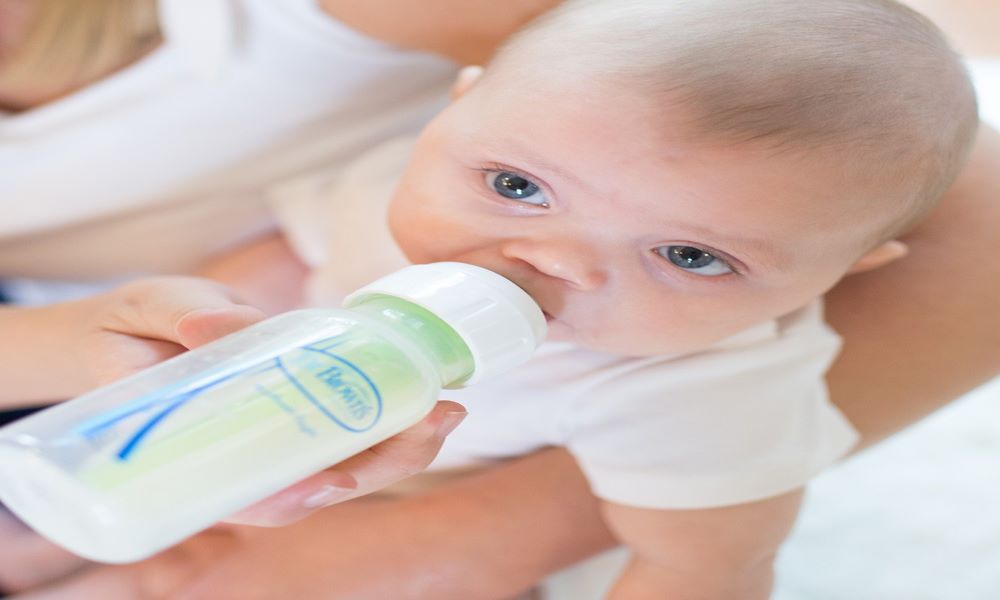Can You Shake Breast Milk? Myths About Breastmilk Storage & Handling
The time after the birth of the baby is a real challenge for parents. Most parents have no clue about handling a newborn. This is especially true if it is their first baby. Parents with their first babies often go through emotional turmoil because whatever happens in their life is new for them. For this reason, they can’t take care of their newborns without seeking online help, help from their doctors, or their elders, including their own parents.
Parents are confused about the most trivial things with their first child. People come up with puzzling questions when they show up to the doctor’s office. Parents become paranoid and ask questions that do not even have scientific support for it. Like can you shake breast milk?
However, it is understandable why parents worry about even the smallest thing regarding their babies. Their concerns can be serious, too, and a doctor or a nurse must answer all the questions that parents have so that they can become satisfied.
Myths And Misconceptions About Breast Milk
There are many myths associated with Newborns, Breastmilk Storage & Handling. Most Breastmilk Storage & Handling myths come from ancient times and have been passed on to this age. However, all the myths give rise to suspicious thoughts, and they hold no accuracy or any truth to it. The worst part is that many people get trapped in such myths, which is why it becomes important to eliminate all these kinds of myths.
There are several myths in this case that still need some research to support it. For instance, One of the most common myths about breast milk many people believe that the first milk that comes out of the woman’s body should be discarded.
There is a myth that shaking breast milk can cause harm to a baby. However, this is not true. Shaking breast milk will not harm a baby in any way. The milk is made up of fat globules and protein particles suspended in a solution of water, sugars, and electrolytes. When the milk is shaken, the fat globules and protein particles mix, resulting in a temporary change in the milk’s appearance. This change does not affect the nutritional value of the milk or its safety for the baby. Many lactation consultants and healthcare providers recommend gently mixing or swirling the milk before feeding it to a baby to ensure that any fat separated from the milk is evenly distributed.
Since the milk’s color is different from the regular milk, it is yellow in color, and the consistency is thicker than the texture of the milk that comes later on, many people think that this kind of milk should be discarded.
However, this myth is completely wrong. The milk that is first produced and released from a woman’s body is known as colostrum. This milk is extremely rich in immune bodies that help boost the new baby’s immunity and works against the organisms in the baby’s body until the baby starts producing its own antibodies.
Therefore, colostrum includes the essential antibodies passed onto the baby as passive immunity to keep the baby healthy against several diseases.
Similarly, the colostrum includes proteins, fats, water, and many other important nutrients for the baby that help in the newborn’s mental and physical growth.
For this reason, the myth that the first milk released from the breasts must be discarded is completely wrong. It should not be practiced. In fact, a woman must feed colostrum to their babies as it contains the right amount of the nutrients that the baby’s body needs to flourish.
On the other hand, there is another myth associated with breast milk, and it is that shaking breast milk ruins it. In this article, we will thoroughly discuss what should be done with breast milk and the right measures that a parent must adopt to store breast milk.
New Mothers need to understand these myths about breastmilk and breastfeeding, so please find all the top myths we compiled and answered them with facts
Myth: Breast milk is not as nutritious as a formula.
Fact: Breast milk is the most complete and nutritious food for infants. It provides all the necessary nutrients, vitamins, and minerals that a baby needs to grow and develop. Formula, on the other hand, is an artificial substitute that can never match the natural composition of breast milk.
Myth: Breastfeeding is painful and uncomfortable.
Fact: While it is normal for breastfeeding to be uncomfortable initially, as a mother and baby learn to latch and breastfeed properly, it should not be painful. If breastfeeding is painful, it is essential to seek help from a healthcare provider or lactation consultant to ensure that the baby is latching correctly and to address any other potential issues.
Myth: Breastfeeding will make your breasts sag.
Fact: Breastfeeding does not cause sagging. The natural changes in a woman’s breasts during pregnancy and breastfeeding are due to hormonal changes and the weight of the milk, not the act of breastfeeding itself. Breastfeeding can help to maintain the shape and size of the breasts by toning the breast tissue and supporting the natural production of collagen.
Myth: You cannot breastfeed if you are on medication.
Fact: Most medications are safe to take while breastfeeding. However, you must talk to your healthcare provider about your medications to ensure they are safe for your baby.
Myth: You cannot breastfeed if you have had breast surgery.
Fact: Many women who have had breast surgery can breastfeed successfully. However, it may be necessary to seek help from a lactation consultant to ensure that your baby is latched on correctly and can get enough milk.
Myth: Breastfeeding is only for poor or uneducated women.
Fact: Breastfeeding benefits both mother and baby, regardless of a woman’s education or socio-economic status. Breastfeeding has been shown to have numerous health benefits for both mother and baby, including reduced risk of breast and ovarian cancer and obesity, asthma, and other chronic diseases for babies.
Myth: Breast milk is not enough to satisfy a baby’s hunger.
Fact: Breast milk is designed to meet a baby’s changing nutritional needs as they grow and develop. It contains the perfect balance of nutrients, and the amount produced by a mother can vary depending on the baby’s age and stage of development. As long as a baby is breastfeeding regularly and gaining weight, there is no need to supplement with formula.
Myth: Breast milk is only beneficial for the first few months of a baby’s life.
Fact: Breast milk provides many benefits throughout a baby’s first year and beyond. It is crucial for supporting a baby’s immune system, helping to protect them against infections and illnesses. Breast milk also provides essential nutrients as a baby grows and starts to eat solid foods.
Myth: Breastfeeding is inconvenient and time-consuming.
Fact: While breastfeeding requires a commitment, it is more convenient than formula feeding. Breast milk is always ready and available, and there is no need to prepare bottles or sterilize equipment. Additionally, breastfeeding can save time and money compared to buying and preparing formula.
Myth: Breast milk is not as nutritious as the formula.
Fact: Breast milk is the perfect food for a baby’s developing body and provides all the nutrients a baby needs in the first six months of life. It contains antibodies that help protect the baby from illness and disease and is easily digestible. On the other hand, a formula can be difficult for some babies to digest and does not provide the same level of protection against illness.
Myth: Breast milk is always the best choice for a baby.
Fact: While breast milk is generally considered the best source of nutrition for infants, there may be some situations where it is not possible or advisable for a mother to breastfeed. In these cases, infant formula can provide an adequate alternative.
Myth: Breast milk loses its nutritional value over time.
Fact: Breast milk remains nutritionally complete and continues to benefit the baby throughout the breastfeeding period. The composition of breast milk changes to meet the needs of the growing baby, with the fatty hindmilk produced at the end of a feeding providing extra calories and nutrients.
Myth: Only full-term, healthy babies can breastfeed.
Fact: Breast milk benefits all infants, including those born prematurely or with health conditions. Breastfeeding can help support the development of preterm infants and provide protection against certain illnesses.
Myth: Breast milk does not provide enough iron for a baby’s needs.
Fact: While breast milk does not contain as much iron as formula, it is easily absorbed by an infant’s body. Breastfed babies are less likely to develop iron-deficiency anemia than formula-fed babies, and breast milk also contains other factors that promote healthy iron levels.
Myth:The formula is just as good as breast milk.
Fact:While the formula is safe and nutritious for feeding infants, it is not nutritionally equivalent to breast milk. Breast milk is specifically designed to meet the unique needs of human infants and contains antibodies and other essential nutrients that cannot be replicated in formula.
Myth:Breastfeeding is only for the first few months of a baby’s life.
Fact:While it is true that breastfeeding is essential during the first few months of a baby’s life, it can also be beneficial for older babies and toddlers. The World Health Organization recommends breastfeeding for at least the first two years of a baby’s life, and many mothers continue breastfeeding for even longer.
Myth: Only women with a specific body type can breastfeed.
Fact: All women can produce enough milk to breastfeed their baby regardless of body type or size. While it is true that some women may produce more milk than others, the amount of milk a woman produces does not determine her ability to breastfeed.
Myth: Breastfeeding is time-consuming.
Fact: While breastfeeding requires time and effort, it can save time in the long run. Breast milk is always ready and does not need to be prepared like formula, and breastfeeding can also help the mother and baby bond, which can be beneficial for their mental and emotional well-being.
Myth: Breastfed babies are not as healthy as formula-fed babies.
Fact: Breastfed babies are generally healthier than formula-fed babies. They are less likely to develop infections, allergies, and chronic conditions such as obesity and diabetes. Breastfed babies also have a lower risk of sudden infant death syndrome (SIDS).
Can you shake breast milk?
The answer to this question is a definite yes. Any liquid a person intake must be shaken well before its usage. The same goes for breast milk that includes all the essential ingredients that the baby needs during his first few days for his survival.
Shaking breast milk brings no harm to the milk. It only further helps because it uniformly mixes the breastmilk ingredients, so when a baby drinks it, he can intake all the nutrients. When breastmilk is stagnant for a long time, that is, for more than thirty minutes, the water sinks to the bottom of the bottle while the fats form a layer on the top.
You can tell that the nutrients have come apart by noticing that the layers have different colors. The fat is more of a pale yellow color, and water is more transparent. Therefore, shaking breast milk blends the content well and allows it to enter the baby’s body uniformly.
It is essential for the baby to consume all the breast milk nutrients properly, especially fats. Fats are the main nutrient that keeps the baby healthy and provides warmth. Also, fats keep the baby full till their next meal.
On the other hand, if you want to check if the breast milk has gone bad or not, you can check this by shaking the breast milk in the bottle. This way, you can check for the milk’s quality, whether it is still fresh or not. You can tell this by noticing if the fats and water have blended well. If the elements do not blend well, it will appear as fat chunks separated from the rest of the milk’s content.
However, if the layers have blended well, it means the milk is still edible and fresh. Another myth associated with it is that shaking breast milk kills nutrients. The main nutrient that people think loses its integrity is protein. Nevertheless, no research has ever proven this statement. The milk proteins still stay the same regardless of how many times you shake the breast milk.
The proteins in breast milk do not break down simply by the act of shaking it. Proteins are strong molecules that are the building blocks of cells in our bodies. However, it must be mentioned here that proteins lose their integrity when heated at high temperatures. For this reason, it may not be wise to heat breast milk at high temperature at the time of storing it but can slightly heat the breast milk to avoid giving baby cold milk.
Related:When To Pump If Breastfeeding Every 2 Hours Complete Pumping Guide
Does shaking breast milk make babies gassy?
This question concerns a lot of new mothers if shaking breast milk makes babies gassy. It is, however, a good concern as the fact is true.
What happens when we shake the bottle is that a lot of air gets mixed in breast milk content. Hence, when a baby intakes this milk, all the air goes to his stomach and makes him have gas in his system. Later on, this gas irritates the baby and keeps him uncomfortable for a long time until the gas has passed.
The best part is that this does not happen very often because getting so much air to mix with the milk means you have to shake the bottle very harshly to get so much air inside it. Only then can such an amount of air mix with the breast milk. Some babies may be more sensitive to gassiness than others, but this is generally not related to the method used to mix the breast milk. If your baby seems to be experiencing excessive gassiness, it is a good idea to talk to your healthcare provider for advice on managing it. In the meantime, you can feed your baby in a more upright position to help reduce the air they swallow and gently burp them during and after feedings.
The solution to this problem is that you can gently swirl the milk bottle instead of shaking it multiple times. Remember giving the bottle a gentle swirl is necessary to blend the contents properly, but not shake it hard to get a lot of air in the bottle.
Swirl VS Shaking:
Swirling and shaking breast milk are two different techniques for mixing the milk before feeding it to a baby. Swirling is a gentler method that involves moving the breast milk in a circular motion to mix the fat and protein particles. Shaking, however, involves more vigorous movement that can cause bubbles to form in the milk. Both swirling and shaking are safe methods for mixing breast milk, and either can be used to evenly distribute the fat in the milk before feeding it to a baby. However, it is essential to avoid shaking the milk too vigorously, as this can cause the milk to become frothy or bubbly, making it more difficult for the baby to drink.
It is much better to give the bottle a light swirl instead of shaking it hard or multiple times. The aim here is to blend the elements well, but at the same time not to ruin the content of the milk by shaking a lot by mixing air with it.








One Reply to “Can You Shake Breast Milk? Myths About Breastmilk Storage & Handling”